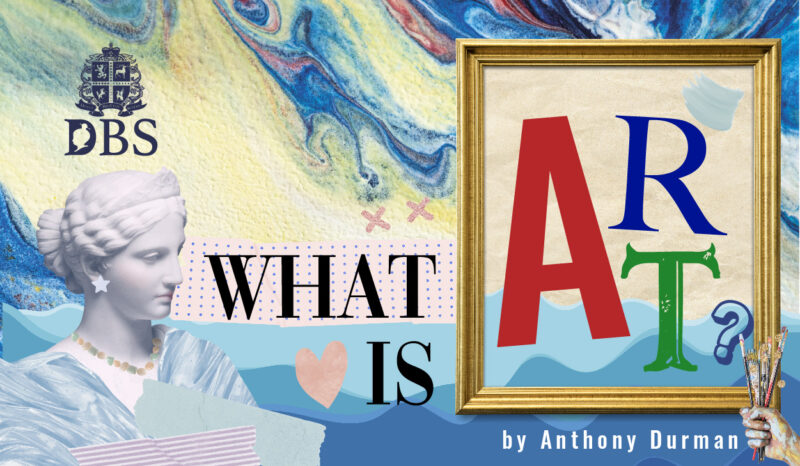What is Art?
As a Teacher of Art, I’m often asked the following 3 question:
What is art? How do you mark art? And why should I learn art?
Art is hard to define exactly because there is no one way to make art. There is no right answer. There are however options. Choices, tools and processes. Fine Art includes drawing, painting, collage, printmaking, ceramics and textiles for example. Digital Art includes photography, Photoshop, filmmaking, Animation, Graphics and Creative Programming. These are skills and tools. How to use these tools requires skill, this we teach. How to use these tools creatively, this we also teach.
Art. Art is what makes us who we are. That inner voice of originality. To produce art is to develop a visual language to communicate thoughts, concepts and emotions. And to view art, to appreciate art is to constantly refresh, to reset our own view of the world. Architects structure buildings, dancers interpret movement and artists shift the way we see.
“Art is standing with one hand extended into the universe and one hand extended into the world, and letting ourselves be a conduit for passing energy’” Albert Einstein
“Art is not what you see, but what you make others see” Edgar Degas
“Creativity is allowing yourself to make mistakes. Art is knowing which ones to keep” Scott Adams
“I found I could say things with color and shapes that I couldn’t say any other way – things I had no words for”. Georgia O’Keeffe
To answer the question: how is Art marked then perhaps it is useful here to refer to the Edexcel Exam board structure and guideline.
Pearsons Edexcel / iGCSE Art & Design
The GCSE / iGCSE Art & Design is divided into two parts. In Year 1 / Component 1 requires a student to develop a Personal Portfolio and in Year 2 / Component 2 a student is set an external exam. The art teacher’s role is to then gently guide a student along this 2 year journey. To introduce students to other artists from which to learn. The art teacher then teaches skill to enable a student to develop that artistic voice. To conclude the journey is a 10 hour exam which provides a student with a concentrated time frame in which to produce a final outcome.
The marking criteria is based on the following 4 Assessment Objects.
- AO1 Develop ideas through investigations, demonstrating critical understanding of sources
- AO2 Refine work by exploring ideas, selecting and experimenting with appropriate media, materials, techniques and processes
- AO3 Record ideas, observations and insights relevant to intentions as work progresses
- AO4 Present a personal and meaningful response that realises intentions and demonstrates understanding of visual language
An exciting 2 year program culminates with accomplished Final Outcome. But an exam is not the end but the start of a journey.
At DBS we are preparing students for international universities and future jobs within the creative industry.
And the final question: So why learn Art?
The Creative Industries
To learn Art, is to learn to think creatively, to develop ideas and flexibility and skill. These skills and this approach are key attributes needed by the ‘‘The Creative Industries’.
The ‘Creative Industries’ is an umbrella term that groups together different sectors to include: Games Design. Television, Film, Fashion, Interactive Digital Media, Mobile App Design Technology, Architecture, Advertising, Marketing & Exhibitions and Virtual Reality to name just a few. This is a multi billion dollar industry and this is global. There are no borders. Pixar, Universal Studios, Google, Apple, Nintendo, Snapchat, Tik Tok and YouTube all need young, innovative and creative minds. From fine art to digital art, from a single image to a sequence of images, film to interactivity and virtual reality this is such an amazing time to study art.
.. and the journey begins with a pencil and learning to draw..
ศิลปะคืออะไร?
ในฐานะครูสอนศิลปะ ผมมักถูกถามคำถาม 3 ข้อต่อไปนี้:
ศิลปะคืออะไร? คุณประเมินผลงานศิลปะอย่างไร? แล้วทำไมต้องฉันต้องเรียนศิลปะ?
การให้คำจำกัดความที่เฉพาะเจาะจงว่าศิลปะนั้นคืออะไรนั้นเป็นสิ่งที่ทำได้ยาก เพราะการสร้างผลงานศิลปะนั้นไม่มีกฎตายตัว มันไม่มีคำตอบที่ถูกต้อง อย่างไรก็ตามศิลปะนั้นมีหลากหลายตัวเลือก หลากหลายเครื่องมือ และหลากหลายกระบวนการ วิจิตรศิลป์จะรวมถึงภาพวาด ภาพระบายสี ภาพคอลลาจ ภาพพิมพ์ เซรามิกส์ และสิ่งทอ เป็นต้น ส่วนศิลปะดิจิตอลจะรวมถึงถ่ายภาพ ภาพจากโปรแกรม Photoshop ภาพยนตร์ แอนิเมชั่น กราฟิก และ Creative Programming ต่าง ๆ สิ่งทั้งหมดที่กล่าวมานี้คือทักษะและเครื่องมือ การใช้เครื่องมือเหล่านี้ต้องอาศัยทักษะ นี่คือสิ่งที่เราสอน และการใช้เครื่องมือเหล่านี้อย่างสร้างสรรค์ ก็คือสิ่งที่เราสอนด้วยเช่นกัน
“ศิลปะคือการที่เรายืนอยู่โดยมีมือมือข้างหนึ่งยื่นเข้าไปในจักรวาลและมืออีกข้างหนึ่งยื่นเข้าไปในโลก และปล่อยให้ตัวเราเป็นสื่อกลางในการสัมผัสกับพลังงานที่ผ่านไปมา” Albert Einstein
“ศิลปะไม่ใช่สิ่งที่คุณเห็น แต่คือสิ่งที่คุณทำให้คนอื่นเห็น” Edgar Degas
“ความคิดสร้างสรรค์คือการปล่อยให้ตัวเองทำผิดพลาด ส่วนศิลปะคือการทำให้เรารู้ว่าควรเก็บผลงานชิ้นใดไว้” Scott Adams
“ฉันพบว่าฉันสามารถพูดถึงสิ่งต่าง ๆ ด้วยสีและรูปทรง ที่ฉันไม่สามารถพูดออกมาเป็นอย่างอื่นได้ – สิ่งที่ฉันไม่สามารถสรรหาคำพูดมาแทนได้” จอร์เจีย โอคีฟเฟ
เพื่อตอบคำถามว่า เราประเมินศิลปะอย่างไร? ผมขออ้างถึงโครงสร้างและแนวทางคณะกรรมการสอบของ Edexcel
Pearsons Edexcel / iGCSE Art & Design
GCSE / iGCSE Art & Design แบ่งออกเป็นสองส่วน ปีที่ 1 / องค์ประกอบที่ 1 กำหนดให้นักเรียนพัฒนาแฟ้มผลงานของตนเอง และในปีที่ 2 / องค์ประกอบที่ 2 นักเรียนจะต้องทำข้อสอบจากหน่วยงานข้างนอก บทบาทของครูสอนศิลปะคือการแนะนำนักเรียนอย่างค่อยเป็นค่อยไปตลอดการเดินทาง ใน 2 ปีนี้ของพวกเขา ครูจะแนะนำให้นักเรียนได้รู้จักกับผลงานของศิลปินคนอื่น ๆ เพื่อที่พวกเขาจะได้เรียนรู้ ครูสอนศิลปะจะสอนทักษะทางศิลปะให้นักเรียนได้สามารถพัฒนาแนวทางหรือรูปแบบศิลปะของตนเอง ส่วนสุดท้ายที่จะสรุปเส้นทางวิชาศิลปะของนักเรียนก็คือการสอบรวมทั้งหมด 10 ชั่วโมงซึ่งให้กรอบเวลาที่เข้มข้นแก่นักเรียนในการสร้างผลงานสุดท้าย
เกณฑ์การให้คะแนนขึ้นอยู่กับการจุดประสงค์ 4 ข้อดังต่อไปนี้
- พัฒนาแนวคิดผ่านการคิดวิเคราะห์ที่แสดงให้เห็นถึงความเข้าใจอย่างลึกซึ้ง
- สร้างผลงานผ่านการสำรวจแนวความคิด คัดเลือก และทดลองกับสื่อ วัสดุ เทคนิคและกระบวนการต่าง ๆ อย่างเหมาะสม
- บันทึกแนวความคิด การสังเกต และข้อมูลเชิงลึกที่เกี่ยวข้องกับเจตนารมณ์ในขณะทำงาน
- นำเสนองานที่สะท้อนตัวตนและมีความหมายที่แสดงให้เห็นถึงเจตนารมณ์และความเข้าใจในการสื่อสารด้วยภาษาภาพ
โปรแกรม 2 ปีที่น่าตื่นเต้นนี้คือการแสดงผลสำเร็จในการเรียน อย่างไรก็ตามการสอบไม่ใช่จุดสิ้นสุด แต่เป็นจุดเริ่มต้นของการเดินทางต่างหาก
ที่โรงเรียนนานาชาติ DBS เรากำลังเตรียมนักเรียนให้พร้อมสำหรับการเรียนต่อในมหาวิทยาลัยระดับนานาชาติและงานในอุตสาหกรรมสร้างสรรค์ในอนาคต
และคำถามสุดท้าย เราเรียนศิลปะไปทำไม?
อุตสาหกรรมสร้างสรรค์
การเรียนศิลปะ คือ การเรียนรู้ที่จะคิดอย่างสร้างสรรค์ พัฒนาแนวความคิด ความยืดหยุ่น และพัฒนาทักษะ ซึ่งทักษะและวิธีคิดแบบนี้เป็นคุณลักษณะสำคัญที่ “อุตสาหกรรมสร้างสรรค์” ต้องการ
‘อุตสาหกรรมสร้างสรรค์‘ คืออุตสาหกรรมที่ควบรวมภาคส่วนต่าง ๆ ไว้ด้วยกัน ทั้งการออกแบบเกม โทรทัศน์ ภาพยนตร์ แฟชั่น สื่อดิจิทัลเชิงโต้ตอบ เทคโนโลยีการออกแบบแอพพลิเคชั่นบนโทรศัพท์มือถือ สถาปัตยกรรม การโฆษณา การตลาดและนิทรรศการ และเทคโนโลยีโลกเสมือนจริง และอื่น ๆ อีกมากมาย นี่คืออุตสาหกรรมที่มีมูลค่าหลายพันล้านเหรียญสหรัฐและเป็นอุตสาหกรรมระดับโลก มันไม่มีพรมแดน บริษัทเช่น Pixar, Universal Studios, Google, Apple, Nintendo, Snapchat, Tik Tok และ YouTube ล้วนต้องการคนรุ่นใหม่ที่มีความคิดริเริ่มและสร้างสรรค์ ตั้งแต่งานวิจิตรศิลป์ไปจนถึงศิลปะดิจิทัล จากภาพเดียวไปจนถึงการลำดับภาพ ภาพยนตร์ ไปจนถึงภาพที่สามารถโต้ตอบกับผู้คนได้ ไปจนถึงเทคโนโลยีโลกเสมือนจริง นี่คือช่วงเวลาที่น่าทึ่งมากในการเรียนศิลปะ
..และการเดินทางนั้นเริ่มต้นด้วยดินสอกับการเรียนรู้ที่จะวาดรูป..









